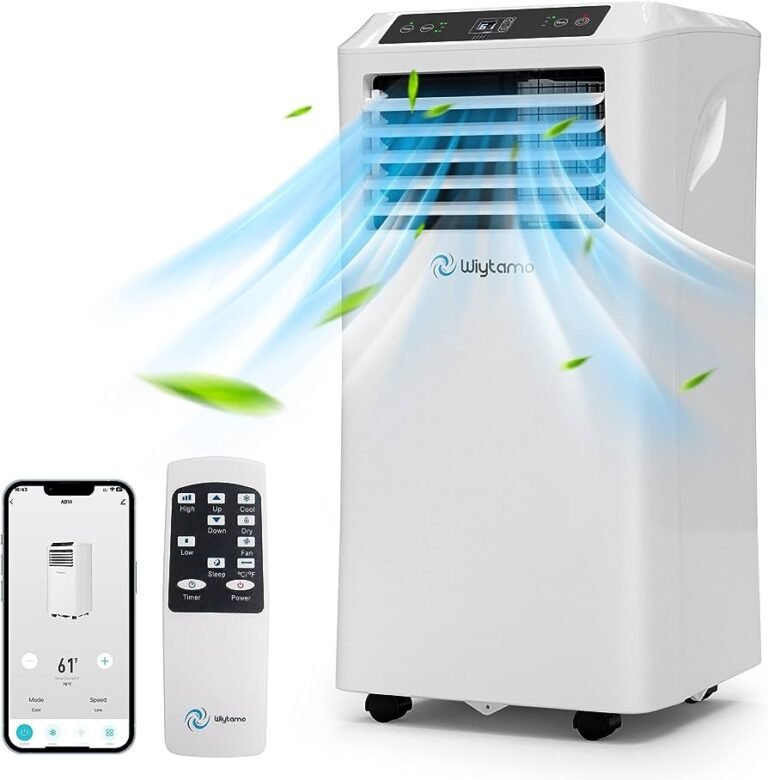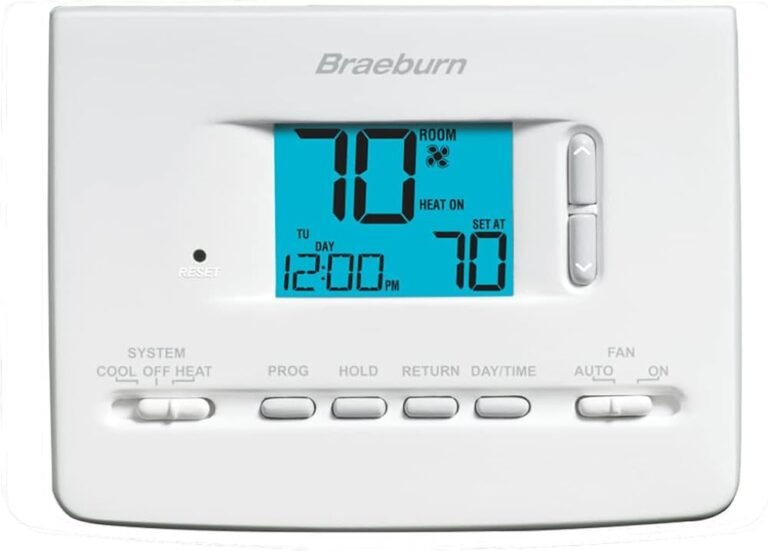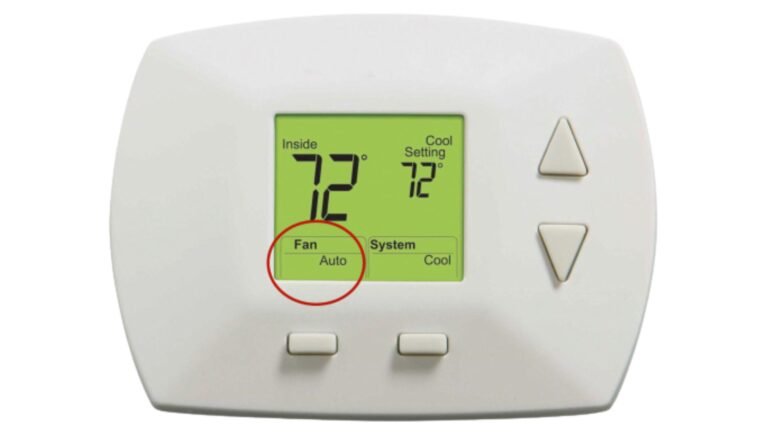Thermostat Secrets: Set At 72 But Reads 80 | Discover the Truth
The thermostat is set at 72 degrees but is actually reading 80 degrees. This could be due to a calibration issue or a faulty thermostat.
If you find that your thermostat is consistently reading a temperature higher than what it’s set at, it could be a sign of a problem. This discrepancy in temperature could lead to discomfort and increased energy consumption. In order to resolve this issue, it’s important to troubleshoot and identify the root cause.
This could involve checking the thermostat’s calibration settings, ensuring proper placement and insulation, or even replacing the thermostat altogether if it’s found to be faulty. By addressing this issue, you can ensure a comfortable and energy-efficient home environment.
The Mysterious Temperature Discrepancy
The thermostat in your home is set at a comfortable 72 degrees, but the display reads a scorching 80 degrees. This temperature discrepancy can be frustrating and confusing, leaving you wondering why the readings are off. You’re not alone in experiencing this issue, as many homeowners have reported similar complaints.
There are several common reasons behind the difference between the thermostat readings and the actual temperature in your home. One possible explanation is improper thermostat placement. If your thermostat is located in a spot that is exposed to direct sunlight, drafts, or other sources of heat, it may not accurately reflect the temperature in the rest of your home.
Another potential cause is a faulty thermostat sensor. Over time, the sensor may become dirty or worn out, leading to inaccurate temperature readings. Additionally, if your thermostat is outdated or improperly calibrated, it may not accurately represent the temperature in your home.
To resolve this issue, consider placing your thermostat in a more suitable location away from direct heat sources and ensure it is properly calibrated. Cleaning or replacing the sensor can also help improve accuracy. If the problem persists, it may be wise to seek assistance from a professional HVAC technician to diagnose and fix any underlying issues with your thermostat.
Unveiling The Thermostat Secrets
In the world of HVAC systems, a common issue homeowners face is a disparity between the temperature set on their thermostat and the readings displayed. For instance, you may have set your thermostat at a comfortable 72 degrees, but find that it reads a perplexing 80 degrees instead.
The underlying secret lies in understanding thermostat calibration and accuracy. Thermostats, like any electronic device, can experience calibration errors over time, causing inaccurate temperature readings. It’s essential to have your thermostat calibrated regularly to ensure precise temperature control.
However, it’s important to note that environmental factors can also influence temperature readings. Factors such as direct sunlight, proximity to appliances or electronics, and even poor insulation can contribute to inaccurate thermostat readings. Therefore, it’s crucial to consider the surroundings and potential sources of temperature fluctuations when evaluating the accuracy of your thermostat.
| Thermostat Secrets: |
| 1. Regularly calibrate your thermostat for accurate temperature control. |
| 2. Environmental factors like direct sunlight and poor insulation can affect readings. |
| 3. Consider the proximity of appliances or electronics to ensure accurate measurements. |
The Truth Behind The Numbers
The thermostat is a crucial component of any heating and cooling system, responsible for maintaining a comfortable temperature in our homes. However, it can be frustrating when the thermostat reading doesn’t match the desired temperature setting. In the case of a thermostat set at 72 degrees Fahrenheit but reading 80, there are a few factors to consider.
One significant consideration is the impact of location on thermostat accuracy. The thermostat’s placement plays a vital role in its ability to accurately measure the temperature. If the thermostat is located near a heat source or in direct sunlight, it may read higher temperatures than the actual room temperature, resulting in a disparity between the set temperature and the reading.
Another important factor to consider is the role of insulation in maintaining desired temperatures. Poorly insulated homes can result in heat loss or gain, impacting the effectiveness of the thermostat. If the house lacks proper insulation, it may take longer for the desired temperature to be reached, leading to a discrepancy between the actual reading and the set temperature.
It’s essential to address these underlying factors to ensure accurate temperature control in your home. Consider repositioning the thermostat away from heat sources or sunlight and improving insulation in your home to enhance the thermostat’s accuracy and efficiency.
Debunking Popular Misconceptions
The myth of “Set at 72 but reads 80” is a common misconception that many people have about their thermostats. It is important to debunk this myth and separate fact from fiction when it comes to thermostat performance.
Firstly, it is important to understand that thermostats are not always accurate. They can have a margin of error and may show a slightly different temperature than what is actually set. This can be due to various factors such as calibration issues or placement of the thermostat.
Secondly, it is important to note that thermostats do not generate heat or cool air themselves. They simply monitor the temperature and signal the heating or cooling system to turn on or off based on the desired set temperature. If your thermostat reads 80 degrees but is set at 72, it could indicate a problem with the heating or cooling system, rather than the thermostat itself.
Lastly, it is recommended to have a professional inspect and calibrate your thermostat to ensure accurate temperature readings. Regular maintenance and cleaning can also help improve the overall performance of your thermostat. By understanding the limitations of thermostats and debunking popular misconceptions, you can ensure optimal comfort and efficiency in your home.
Insider Tips For Accurate Temperature Control
Having your thermostat set at 72 but reading 80 can be frustrating. To ensure accurate temperature control, it’s important to calibrate your thermostat. Start by checking the placement of your thermostat. Make sure it’s away from direct sunlight, drafts, and heat sources like lamps or electronics. Clean the thermostat regularly to remove any dust or debris that may interfere with its performance.
Consider adjusting your thermostat’s settings to maximize energy efficiency while still maintaining comfort. Program your thermostat to lower or raise the temperature during times when you’re away or sleeping. This can help reduce energy consumption without sacrificing comfort. Additionally, use the fan setting wisely; running the fan continuously can help distribute conditioned air more evenly throughout your home.
In conclusion, by properly calibrating your thermostat and adjusting settings for optimal performance, you can achieve accurate temperature control in your home. This not only enhances your comfort but also helps save energy and reduce utility costs.
The Future Of Thermostat Technology
Smart thermostats are taking temperature control to a whole new level. With advanced features powered by machine learning and AI, these devices are revolutionizing the way we interact with our home’s environment. The future of thermostat technology is here, and it’s designed to provide a seamless experience for homeowners.
One of the key benefits of smart thermostats is their ability to learn and adapt to our comfort preferences. By analyzing our daily routines and adjusting temperature settings accordingly, these devices ensure that our homes are always at the ideal temperature.
The integration of AI enables smart thermostats to provide personalized energy-saving recommendations. They can detect patterns in our behavior and make suggestions on how to optimize energy usage, leading to cost savings and reducing environmental impact.
Additionally, smart thermostats can be controlled remotely through smartphone apps or voice commands, allowing for greater convenience and flexibility. Whether you’re at work or on vacation, you can easily adjust the temperature in your home to ensure maximum comfort upon your return.
| Key Features of Smart Thermostats | Benefits |
|---|---|
| Analyzing daily routines | – Ensures ideal temperature settings |
| Machine learning capabilities | – Personalized energy-saving recommendations |
| Remote control via smartphone | – Convenient and flexible temperature adjustments |
In conclusion, the rise of smart thermostats equipped with machine learning and AI brings immense benefits to homeowners. With their ability to learn and adapt, provide energy-saving recommendations, and offer remote control capabilities, these devices are shaping the future of thermostat technology.
Take Control Of Your Home’S Comfort
| Subheading | Action Steps |
|---|---|
| Simple steps to troubleshoot temperature discrepancies |
|
Expert advice on maintaining the ideal indoor climate. It can be frustrating when your thermostat shows a different temperature than what you’ve set it to. However, by following a few simple steps, you can troubleshoot temperature discrepancies and regain control of your home’s comfort.
First, check for any obstructions around your thermostat that may be affecting its temperature reading accuracy. Objects like furniture or curtains placed too close to the thermostat can interfere with its sensors.
Next, validate the calibration of your thermostat by comparing it with an external thermometer. This will help determine if it’s displaying the correct temperature.
Ensure your air vents are clean and unobstructed to allow proper airflow. Blocked vents can lead to inconsistent temperature distribution throughout your home.
If the problem persists, try performing a system reset by turning off the power to your HVAC unit and then restarting it. Sometimes, a simple reset can resolve minor issues.
Review your thermostat’s settings to ensure that they are programmed correctly and not causing any conflicts. Incorrect or conflicting settings can lead to temperature variations.
If none of these steps resolve the issue, it may be worth seeking the assistance of a professional HVAC technician. They can provide further diagnosis and repair any underlying problems with your system.
:extract_cover():upscale()/2022/02/10/762/n/1922507/6a5a5bf177aadfc3_netimgTYNLA6.jpg)
Credit: www.popsugar.com
Frequently Asked Questions Of Thermostat Set At 72 But Reads 80
Why Is My Ac Set At 72 But Reads 80?
Your AC may read 80 even if set at 72 due to issues such as thermostat calibration or air duct leaks.
Why Is My Thermostat Reading Higher Than Setting?
Thermostat may read higher due to placement near heat sources, malfunctioning sensors, or system issues.
Why Is My Ac Set To 73 But Reads 78?
Your AC might be reading higher than the temperature you set due to possible sensor issues or lack of maintenance.
Why Does My Thermostat Keep Going Up To 80?
Your thermostat may be set to 80 degrees due to a malfunction or incorrect programming.
Conclusion
The inconsistency between the thermostat set at 72 degrees but reading 80 degrees can be frustrating and lead to discomfort in your home. To address this issue, there are a few potential causes to consider. First, it is worth checking the thermostat’s location to ensure it is not affected by direct sunlight or heat sources.
Additionally, you may want to verify that the thermostat is properly calibrated and functioning correctly. If these steps do not resolve the issue, there may be a problem with the HVAC system itself, such as a faulty sensor or improper airflow.
In such cases, it is advisable to consult a professional technician who can diagnose and fix the problem. By addressing the root cause of the discrepancy between the set temperature and the reading, you can ensure a comfortable and consistent indoor environment.





